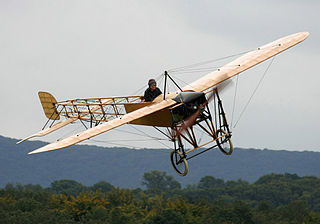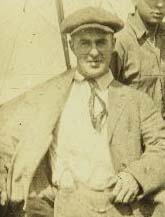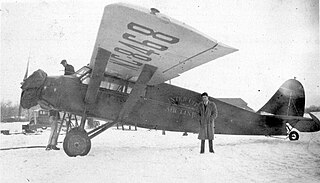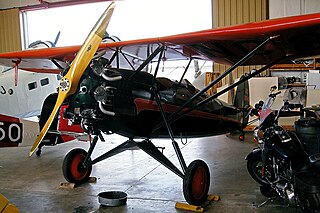Related Research Articles
Parnall was a British aircraft manufacturer that evolved from a wood-working company before the First World War to a significant designer of military and civil aircraft into the 1940s. It was based in the west of England and was originally known as George Parnall & Co. Ltd.

Henry Adler Berliner was a United States aircraft and helicopter pioneer.

The Blériot XI is a French aircraft of the pioneer era of aviation. The first example was used by Louis Blériot to make the first flight across the English Channel in a heavier-than-air aircraft, on 25 July 1909. This is one of the most famous accomplishments of the pioneer era of aviation, and not only won Blériot a lasting place in history but also assured the future of his aircraft manufacturing business. The event caused a major reappraisal of the importance of aviation; the English newspaper The Daily Express led its story of the flight with the headline "Britain is no longer an Island".

Farman Aviation Works was a French aircraft company founded and run by the brothers Richard, Henri, and Maurice Farman. They designed and constructed aircraft and engines from 1908 until 1936; during the French nationalization and rationalization of its aeronautical industry, Farman's assets were assigned to the Société Nationale de Constructions Aéronautiques du Centre (SNCAC).

Otto William Timm was a California-based barnstormer and aircraft manufacturer of German descent. Charles Lindbergh's first flight was flown by Timm. Timm partnered at times with his brother Wally Timm who did a lot of flying for the nascent Hollywood movie industry.
Sometimes dubbed the Golden Age of Aviation, the period in the history of aviation between the end of World War I (1918) and the beginning of World War II (1939) was characterised by a progressive change from the slow wood-and-fabric biplanes of World War I to fast, streamlined metal monoplanes, creating a revolution in both commercial and military aviation. By the outbreak of World War II in 1939 the biplane was all but obsolete. This revolution was made possible by the continuing development of lightweight aero engines of increasing power. The jet engine also began development during the 1930s but would not see operational use until later.

Blériot Aéronautique was a French aircraft manufacturer founded by Louis Blériot. It also made a few motorcycles between 1921 and 1922 and cyclecars during the 1920s.

The Stinson Detroiter was a six-seat cabin airliner for passengers or freight designed and built by the Stinson Aircraft Syndicate, later the Stinson Aircraft Corporation. Two distinct designs used the Detroiter name, a biplane and a monoplane.

The Texas-Temple Sportsman is an American-built light single-seat high-wing sporting monoplane of the late 1920s.

The Davis D-1 is an American light two-seat parasol-winged monoplane of the late 1920s.
Davis Aircraft Corporation was an American aircraft manufacturer.

Doyle Aero Corporation was an American aircraft manufacturer.

The Doyle Aero O-2 Oriole or Doyle O-2 was a parasol wing aircraft.

The Vulcan American Moth Monoplane was an early parasol-wing monoplane developed by the Doyle brothers.

The Lindbergh Boom (1927–1929) is a period of rapid interest in aviation following the awarding of the Orteig Prize to Charles Lindbergh for his 1927 non-stop solo transatlantic flight in the Spirit of St. Louis. The Lindbergh Boom occurred during the interwar period between World War I and World War II, where aviation development was fueled by commercial interests rather than wartime necessity. During this period, dozens of companies were formed to create airlines, and aircraft for a new age in aviation. Many of the fledgling companies funded by stock went under as quick as they started as the stock that capitalized them plummeted in value following the Wall Street Crash of 1929. The Great Depression dried up the market for new aircraft, causing many aircraft companies to go into bankruptcy or get consolidated by larger entities. Air racing, record attempts, and barnstorming remained popular, as aviators tried to recapture the prizes and publicity of Lindbergh's Transatlantic flight.

The Texas Aero Corporation of Temple, Texas was formed about 1927 to construct passenger and mail light aircraft. The company's origin can be traced back to George W Williams Texas Aero Manufacturing Company of 1911.
References
- ↑ Harvey Doyle (December 1986). "American Moth". Sport Aviation.
- ↑ "The Flight of the American Moth" . Retrieved 30 May 2012.
- ↑ "Ohio Good Will Tour Planes to Put On Exhibition". The Palm Beach Post. 6 March 1928.
- ↑ "Vulcan Aircraft Company" . Retrieved 30 May 2012.
- ↑ Harvey Doyle (March 1987). "A New Date With An Old Love". Sport Aviation.
- ↑ Air Trails. 1 January 1988.Missing or empty
|title=(help)